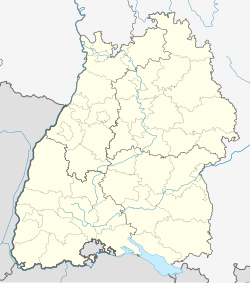world.wikisort.org - Germany
Mauer is a village in south western Germany. It is located between Heidelberg and Sinsheim in the Rhein-Neckar district in the state of Baden-Württemberg.
This article may be expanded with text translated from the corresponding article in German. (February 2009) Click [show] for important translation instructions.
|
This article needs to be updated. (June 2012) |
Mauer | |
|---|---|
Municipality | |
 Town hall | |
 Coat of arms | |
Location of Mauer within Rhein-Neckar-Kreis district  | |
 Mauer  Mauer | |
| Coordinates: 49°20′20″N 08°47′55″E | |
| Country | Germany |
| State | Baden-Württemberg |
| Admin. region | Karlsruhe |
| District | Rhein-Neckar-Kreis |
| Government | |
| • Mayor (2020–28) | John Ehret[1] |
| Area | |
| • Total | 6.30 km2 (2.43 sq mi) |
| Elevation | 131 m (430 ft) |
| Population (2020-12-31)[2] | |
| • Total | 4,071 |
| • Density | 650/km2 (1,700/sq mi) |
| Time zone | UTC+01:00 (CET) |
| • Summer (DST) | UTC+02:00 (CEST) |
| Postal codes | 69256 |
| Dialling codes | 06226 |
| Vehicle registration | HD |
| Website | www.gemeinde-mauer.de |
On 1 June 2012, John Ehret (no party) took office as mayor. He is the first black mayor in Baden-Württemberg and thought to be the first black mayor in Germany in modern times.[3]
Geography
Mauer is located at an altitude of 130–240 m, and covers an area of 630 hectares. Of this area, 22.8% is covered by settlements, roads and paved areas, 55.3% is agricultural, and 18.6% is forested. Adjacent municipalities are, starting in the north and moving clockwise, Wiesenbach, Meckesheim, Wiesloch, Leimen and Bammental.
Religion
In 1522, the Reformation was introduced into Mauer; probably by Franz von Sickingen. Today it hosts both an evangelical and a Roman Catholic church community.
Geology/Archaeology
Mauer is the location where the first remains of Homo heidelbergensis were found. The remains, a jaw, were discovered in 1907 in the local sand quarry by Daniel Hartmann, a worker there. The sandpit remained active for some time, and the original resting place of the remains no longer exists. However, the sandpit is now a nature park, and the sedimentary layers corresponding to those of the original find can be viewed on a 25 meter high section.
Persons of Interest
Honored Citizens
- Daniel Hartmann (1854-1952) found the lower jaw of Homo heidelbergensis.
- Gerhard Weiser (1931-2003) was Mayor of Mauer from 1962 to 1976. In 1968 he moved to the Landtag for the first time and later became the Minister of Agriculture in Baden-Württemberg from 1976 to 1996. From 1996 to 2001 he was vice-president of the state parliament. In spite of his political commitment, he remained connected to his hometown and also managed a farm there.
- Erich Mick, mayor from 1976 to 2001, founder of the association Homo heidelbergensis of Mauer e.V.
Other Notables Associated with Mauer
- Karl von Zyllnhardt (forestry officer) (1744-1816), German landlord and forestry officer.
- Karl von Zyllnhardt (jurist) (1779-1828), German jurist and politician.
References
- Aktuelle Wahlergebnisse, Staatsanzeiger, accessed 14 September 2021.
- "Bevölkerung nach Nationalität und Geschlecht am 31. Dezember 2020" [Population by nationality and sex as of December 31, 2020] (CSV). Statistisches Landesamt Baden-Württemberg (in German). June 2021. Retrieved 17 October 2021.
- "Germany elects first ever black mayor". The Local. 2 June 2012. Retrieved 2012-06-09.
На других языках
- [en] Mauer (Baden)
[ru] Мауэр (Баден)
Мауэр (нем. Mauer) — коммуна в Германии, в земле Баден-Вюртемберг.Другой контент может иметь иную лицензию. Перед использованием материалов сайта WikiSort.org внимательно изучите правила лицензирования конкретных элементов наполнения сайта.
WikiSort.org - проект по пересортировке и дополнению контента Википедии
